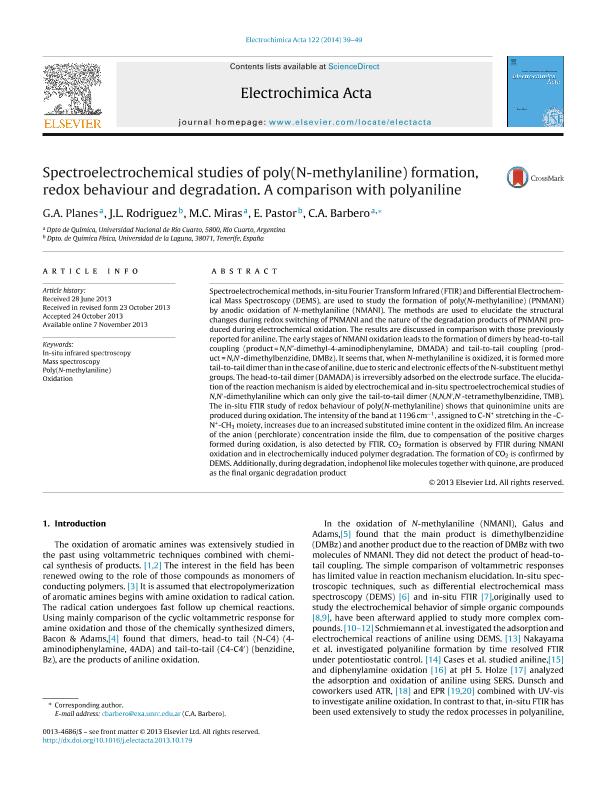Mostrar el registro sencillo del ítem
dc.contributor.author
Planes, Gabriel Angel

dc.contributor.author
Rodriguez, Jose Luis

dc.contributor.author
Miras, Maria Cristina

dc.contributor.author
Tejera, Elena Pastor
dc.contributor.author
Barbero, César Alfredo

dc.date.available
2018-01-17T16:11:07Z
dc.date.issued
2014-03
dc.identifier.citation
Barbero, César Alfredo; Tejera, Elena Pastor; Planes, Gabriel Angel; Rodriguez, Jose Luis; Miras, Maria Cristina; Spectroelectrochemical studies of poly(N-methylaniline) formation, redox behaviour and degradation. A comparison with polyaniline; Pergamon-Elsevier Science Ltd.; Electrochimica Acta; 122; 3-2014; 39-49
dc.identifier.issn
0013-4686
dc.identifier.uri
http://hdl.handle.net/11336/33603
dc.description.abstract
Spectroelectrochemical methods, in-situ Fourier Transform Infrared (FTIR) and Differential Electrochemical Mass Spectroscopy (DEMS), are used to study the formation of poly(N-methylaniline) (PNMANI) by anodic oxidation of N-methylaniline (NMANI). The methods are used to elucidate the structural changes during redox switching of PNMANI and the nature of the degradation products of PNMANI produced during electrochemical oxidation. The results are discussed in comparison with those previously reported for aniline. The early stages of NMANI oxidation leads to the formation of dimers by head-to-tail coupling (product = N,N’-dimethyl-4-aminodiphenylamine, DMADA) and tail-to-tail coupling (product = N,Ń-dimethylbenzidine, DMBz). It seems that, when N-methylaniline is oxidized, it is formed more tail-to-tail dimer than in the case of aniline, due to steric and electronic effects of the N-substituent methyl groups. The head-to-tail dimer (DAMADA) is irreversibly adsorbed on the electrode surface. The elucidation of the reaction mechanism is aided by electrochemical and in-situ spectroelectrochemical studies of N,Ń-dimethylaniline which can only give the tail-to-tail dimer (N,N,Ń,Ń-tetramethylbenzidine, TMB). The in-situ FTIR study of redox behaviour of poly(N-methylaniline) shows that quinonimine units are produced during oxidation. The intensity of the band at 1196 cm−1, assigned to C-N+ stretching in the -C-N+-CH3 moiety, increases due to an increased substituted imine content in the oxidized film. An increase of the anion (perchlorate) concentration inside the film, due to compensation of the positive charges formed during oxidation, is also detected by FTIR. CO2 formation is observed by FTIR during NMANI oxidation and in electrochemically induced polymer degradation. The formation of CO2 is confirmed by DEMS. Additionally, during degradation, indophenol like molecules together with quinone, are produced as the final organic degradation product
dc.format
application/pdf
dc.language.iso
eng
dc.publisher
Pergamon-Elsevier Science Ltd.

dc.rights
info:eu-repo/semantics/openAccess
dc.rights.uri
https://creativecommons.org/licenses/by-nc-sa/2.5/ar/
dc.subject
In-Situ Infrared Spectroscopy
dc.subject
Mass Spectroscopy
dc.subject
Poly(N-Methylaniline)
dc.subject
Oxidation
dc.subject.classification
Otras Ciencias Químicas

dc.subject.classification
Ciencias Químicas

dc.subject.classification
CIENCIAS NATURALES Y EXACTAS

dc.title
Spectroelectrochemical studies of poly(N-methylaniline) formation, redox behaviour and degradation. A comparison with polyaniline
dc.type
info:eu-repo/semantics/article
dc.type
info:ar-repo/semantics/artículo
dc.type
info:eu-repo/semantics/publishedVersion
dc.date.updated
2018-01-17T15:02:41Z
dc.journal.volume
122
dc.journal.pagination
39-49
dc.journal.pais
Estados Unidos

dc.journal.ciudad
Amsterdam
dc.description.fil
Fil: Planes, Gabriel Angel. Consejo Nacional de Investigaciones Científicas y Técnicas; Argentina. Universidad Nacional de Río Cuarto. Facultad de Ciencias Exactas Fisicoquímicas y Naturales. Departamento de Química; Argentina
dc.description.fil
Fil: Rodriguez, Jose Luis. Universidad de la Laguna. Tenerife; España
dc.description.fil
Fil: Miras, Maria Cristina. Universidad Nacional de Río Cuarto. Facultad de Ciencias Exactas Fisicoquímicas y Naturales. Departamento de Química; Argentina
dc.description.fil
Fil: Tejera, Elena Pastor. Universidad de la Laguna. Tenerife; España
dc.description.fil
Fil: Barbero, César Alfredo. Universidad Nacional de Río Cuarto. Facultad de Ciencias Exactas Fisicoquímicas y Naturales. Departamento de Química; Argentina
dc.journal.title
Electrochimica Acta

dc.relation.alternativeid
info:eu-repo/semantics/altIdentifier/doi/http://dx.doi.org/10.1016/j.electacta.2013.10.179
dc.relation.alternativeid
info:eu-repo/semantics/altIdentifier/url/http://www.sciencedirect.com/science/article/pii/S0013468613021506
Archivos asociados
